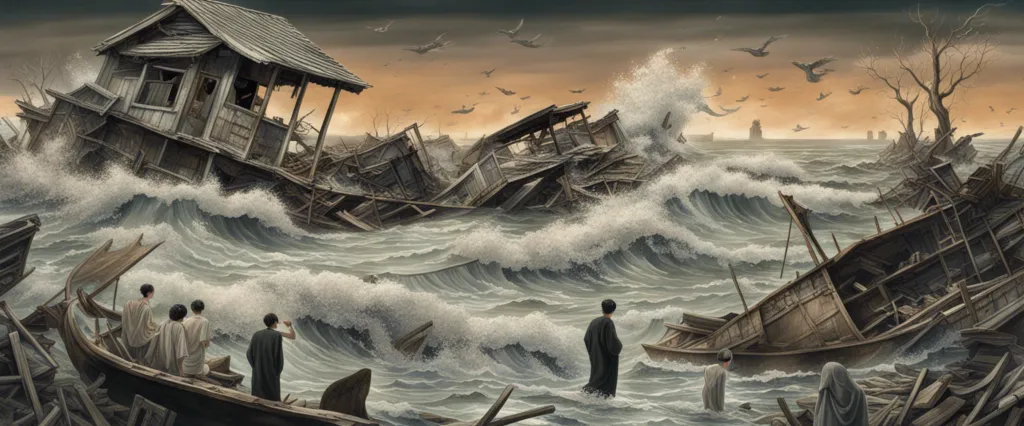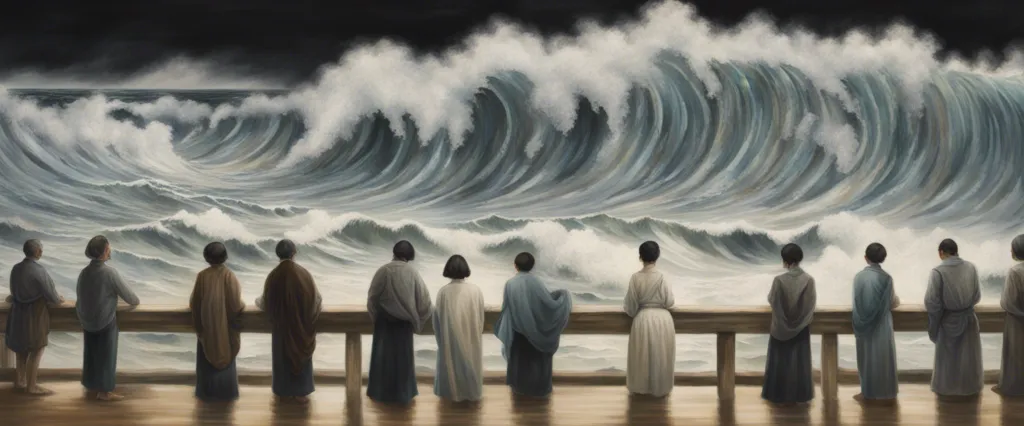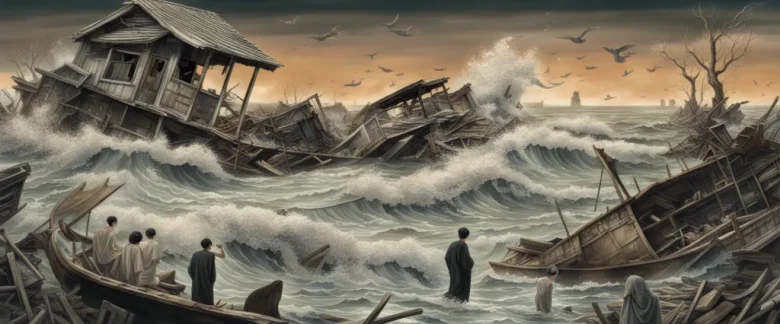
In his haunting memoir, “Ghosts of the Tsunami,” Richard Lloyd Parry delves into the tragic aftermath of the 2011 Tohoku earthquake and tsunami that struck the northeastern coast of Japan. In this gripping account, Parry relays the heart-wrenching stories of those affected by the disaster, capturing the immense loss and the hellish journey towards healing. With his background as the Asia editor for “The Times” and over two decades of experience reporting on Japan, Parry brings a wealth of knowledge and empathy to this deeply moving narrative.
Chapter 1: The Great Wave
Chapter 1 of “Ghosts of the Tsunami” by Richard Lloyd Parry, titled “The Great Wave,” recounts the tragic events of March 11, 2011, when a massive tsunami struck the northeastern coast of Japan. The chapter sets the scene by describing the peacefulness of the region, with its small fishing villages and serene countryside.
On that fateful day, the region was struck by a 9.0 magnitude earthquake, triggering one of the most destructive tsunamis in history. Parry provides vivid details of the terrifying moments when the ground shook violently, schools collapsed, and people ran for their lives. The tsunami, with waves exceeding 40 meters in height, obliterated entire towns, claiming the lives of more than eighteen thousand people.
The narrative focuses on the Okawa Elementary School in Ishinomaki, where two hundred and forty-four children and ten teachers perished. Parry explores the harrowing last moments of these innocent lives, their frantic calls for help, and the heartbreaking attempts of parents and teachers to save them.
The author also delves into the aftermath of the disaster, narrating the struggles of devastated parents searching for their missing children and the emotional trauma experienced by survivors. He highlights the ethical dilemma faced by the school’s headmaster, who chose to conserve the bodies of the deceased in order to avoid further distress to the parents.
Through the re-telling of individual accounts and interviews with survivors, Parry offers a haunting and intimate portrayal of the unimaginable human suffering caused by the tsunami. He sets the stage for the profound themes and collective trauma that he will delve into further in the subsequent chapters, leaving readers with an overwhelming sense of the destructive power of nature and the enduring impact it has on its survivors.
Chapter 2: Tragedy Strikes
Chapter 2 of “Ghosts of the Tsunami” by Richard Lloyd Parry, titled “Tragedy Strikes”, delves into the devastating events of the Great East Japan Earthquake and ensuing tsunami that struck Japan on March 11, 2011. The chapter focuses on exploring the immense power of the tsunami and the devastating impacts it had on the coastal town of Okawa.
Parry introduces us to the Okawa Elementary School, where 74 children and 10 teachers tragically lost their lives due to the tsunami. He describes the town’s serene setting, nestled between gentle hills and a river, oblivious to the imminent disaster approaching it.
On that fateful day, the school failed to evacuate the children promptly due to insufficient preparations and a flawed safety plan. As the tsunami warning was announced, the teachers herded the students towards the riverbank, believing it would provide them safety. However, the wave soon overwhelmed the river, washing away the entire school building along with the children and teachers inside. Only four students miraculously survived, but they were forever traumatized by the horrors they had witnessed.
Parry utilizes survivor testimonies, rescue worker accounts, and vivid descriptions to portray the heart-wrenching scene of the aftermath. The community experiences overwhelming grief and a sense of betrayal towards the school authorities. The chapter also delves into the subsequent investigation and the efforts made by parents to seek justice, uncovering the negligence that directly contributed to the high number of casualties.
In summary, Chapter 2 of “Ghosts of the Tsunami” highlights the horrifying impact of the tsunami on Okawa Elementary School and its devastating consequences. It exposes the failure of the school’s safety protocols and sets the stage for the search for accountability in the midst of immense tragedy.
Chapter 3: Searching for the Missing
Chapter 3 of “Ghosts of the Tsunami” by Richard Lloyd Parry is titled “Searching for the Missing.” In this chapter, Parry focuses on the aftermath of the devastating tsunami that struck Japan on March 11, 2011, and specifically on the search for missing individuals.
The chapter begins by describing the scene at the community center in Natori City, where relatives of the missing gather to obtain information about their loved ones. Amidst the overwhelming chaos and anguish, volunteers contact hospitals and compile a list of the injured, hoping to find clues about those who remain unaccounted for.
Parry introduces us to some of the families, sharing their stories and the emotional toll that the uncertainty surrounding the fate of their loved ones has taken on them. He focuses particularly on the story of Yuko Sugawara, who has lost her two sons and her parents. Her desperation to find her missing children engulfs her life completely.
Parry also delves into the psychological and cultural complexities of searching for the missing in Japan. He explores the traditional belief that spirits of the dead should be properly laid to rest, which explains the emphasis on finding bodies and the reluctance to declare someone dead without physical evidence.
The chapter further delves into the immense task faced by the authorities and volunteers who comb through debris and wreckage, desperately searching for any signs of life. Parry emphasizes the exhaustion and emotional toll on these individuals, who are confronted with the stark contrast between the vastness of destruction and the limited resources available to them.
Chapter 3 of “Ghosts of the Tsunami” serves as a poignant and powerful portrayal of the search for the missing in the aftermath of one of Japan’s most devastating natural disasters. It captures the heart-wrenching stories of the families left in limbo, their desperate attempts to find closure, and the overwhelming challenges faced by those involved in the recovery efforts.
Chapter 4: Grief and Mourning

Chapter 4: Grief and Mourning of the book “Ghosts of the Tsunami” by Richard Lloyd Parry explores the profound impact of the 2011 Japanese tsunami on the survivors’ grieving and mourning process. Parry delves into the story of a single school, Okawa Elementary, which lost 74 out of 108 students during the disaster.
The chapter begins by highlighting the different cultural aspects of grief and mourning in Japan. Traditional Japanese mourning practices involve elaborate rituals and a strong emphasis on collective mourning. However, the sheer scale of the tsunami overwhelmed these practices, leaving survivors grappling with how to mourn such an immense loss.
Parry introduces Yoshio Kamogawa, whose eight-year-old daughter, Yūko, perished in the tsunami. Kamogawa becomes a central figure in the chapter as he embarks on a quest for answers and justice. Fueled by grief, he relentlessly investigates the decisions made by Okawa Elementary’s teachers that led to the students’ deaths. His quest becomes a form of coping, offering him hope for closure and a way to remember his daughter’s life.
Additionally, the chapter explores the psychological and emotional toll experienced by the survivors. Some of Okawa Elementary’s bereaved parents turn to mediums and psychics seeking spiritual guidance, while others find solace in sharing their stories through support groups. Their beliefs and coping mechanisms vary widely, showing the complexity of individual grief and recovery.
Parry concludes the chapter by highlighting how grief evolves and reshapes over time. The survivors slowly adapt to their losses, finding new ways to honor the memories of their loved ones and rebuild their lives. The chapter emphasizes the resilience of the human spirit and the power of collective mourning as the community gradually moves forward while keeping the ghosts of their lost loved ones alive.
Chapter 5: The Aftermath and Rebuilding
Chapter 5, titled “The Aftermath and Rebuilding,” delves into the devastating consequences of the 2011 Tohoku earthquake and tsunami in Japan, as documented by Richard Lloyd Parry in “Ghosts of the Tsunami.” This section focuses on the aftermath of the disaster, the subsequent efforts in rebuilding the affected areas, and the psychological trauma experienced by survivors.
Parry highlights the massive destruction caused by the immense tidal wave, which claimed the lives of thousands and left entire communities in ruins. He portrays the desperate struggle of survivors, many of whom lost family members and their homes. The aftermath is characterized by a sense of shock and disbelief as people attempt to comprehend the immense scale of the disaster.
The author examines the painstaking reconstruction efforts undertaken by the Japanese government, which aimed to restore the devastated areas and provide shelter for the survivors. The process was not without challenges, as bureaucrats often clashed with local community leaders and residents over issues like the location of temporary housing and restoration plans.
Parry also delves into the lasting psychological impact the catastrophe had on the survivors. He explores the concept of “ghosts,” in which the memories and spirits of the deceased continue to haunt the living. The bereaved families struggle to come to terms with their loss, regularly visiting the sites where their loved ones perished and dealing with survivors’ guilt.
In this chapter, Parry emphasizes the resilience and strength of the survivors, describing their determination to rebuild their lives amidst profound grief and loss. The chapter serves as a poignant reminder of the long-lasting effects of natural disasters, showcasing both the physical and emotional challenges faced by those who experienced this tragic event.
Chapter 6: The Ghosts of the Tsunami
In Chapter 6: The Ghosts of the Tsunami from Richard Lloyd Parry’s book Ghosts of the Tsunami, the author delves into the aftermath and long-lasting emotional impact of the 2011 tsunami that devastated northeastern Japan. Parry recounts the traumatic experiences of survivors who lived through the disaster and the various ways in which they were haunted by its memory.
The chapter begins with the story of Yūka Abe, a young girl who miraculously survived the tsunami after being washed away from her school. Parry explores the psychological effects suffered by Yūka and other survivors who experienced survivor’s guilt, nightmares, and a deep sense of loss. He highlights the unique cultural and societal expectations that contribute to the survivors’ prolonged suffering and grief.
Parry describes the three stages of recovery experienced by the survivors as described by psychiatrist Dr. Kōichi Yoshida. The first stage involves the initial shock and numbness that comes with the immediate aftermath of the disaster. In the second stage, the survivors experience a deep sense of loss and must confront the reality of their losses, including loved ones who perished. The final stage centers around the survivors’ efforts to rebuild their lives and create a new normal amidst the pain.
The author also explores the role of traditional religious practices in comforting the survivors and providing solace. He details the efforts of Buddhist priest Jōdo Wasō, who conducts memorial ceremonies for those lost in the tsunami. These ceremonies help survivors cope with their grief and connect with their lost loved ones.
Throughout the chapter, Parry emphasizes the profound effects of the tsunami on the survivors’ mental and emotional well-being. The ghost-like presence of the deceased and the enduring trauma of the disaster continue to haunt the lives of those who experienced it firsthand, leaving them forever changed and in constant pursuit of healing and closure.
Chapter 7: Unanswered Questions
Chapter 7: Unanswered Questions of the book Ghosts of the Tsunami by Richard Lloyd Parry delves deeper into the aftermath of the 2011 Tohoku earthquake and the subsequent devastating tsunami in Japan. This chapter explores the lingering mysteries and unanswered questions that continue to haunt the survivors and the wider community.
Parry begins by focusing on a particular school in Okawa, where over 70 students and teachers were killed during the disaster. He investigates the controversial actions and decisions taken by school officials that led to the deaths of so many young lives. Parry highlights the lack of accountability and the subsequent cover-up attempts by authorities, which only added to the grief and frustration felt by the families.
The chapter then delves into the supernatural and mystical beliefs held by some survivors as a way to cope with their immense loss. Parry introduces readers to a woman named Watanabe, who claims to possess the ability to communicate with the deceased. He explores the complex dynamics of grief and how individuals seek solace in different ways, even if it entails embracing the unknown.
Parry also brings attention to the issue of suicide, which surged following the disaster. He examines several cases in which survivors chose to end their lives, exploring the psychological toll and desperate circumstances that led them to such a devastating choice.
Throughout the chapter, Parry emphasizes the lack of closure and the unanswered questions that persist in the wake of the tragedy. The families of the victims, the survivors, and even Parry himself are left grappling with the magnitude of the disaster and the profound impact it continues to have on their lives.
In summary, Chapter 7 of Ghosts of the Tsunami highlights the profound impact of the disaster on the survivors and the community, focusing on the ongoing search for answers and closure amidst grief, the mystical attempts to communicate with the deceased, and the increase in suicides as a tragic response to the trauma.

Chapter 8: Lessons Learned and Moving Forward
Chapter 8 of Ghosts of the Tsunami by Richard Lloyd Parry, titled “Lessons Learned and Moving Forward,” explores the aftermath of the devastating 2011 Tohoku earthquake and tsunami in Japan. This chapter focuses on the lessons learned from the tragedy and the efforts made to move forward.
The chapter begins by highlighting the investigations conducted by Japanese authorities and the government’s admission of its failure to adequately prepare for such a disaster. Parry emphasizes the shortcomings, including an unresponsive and ineffective emergency infrastructure, a lack of clear communication, and a complacent attitude towards the possibility of a massive tsunami. The author interviews survivors, scientists, and officials to understand the extent of the failures and the need for accountability.
Parry also addresses the emotional impact on the survivors and the ongoing struggle of rebuilding their lives. He recounts personal stories of those who lost loved ones, homes, and livelihoods, painting a poignant picture of grief, resilience, and the slow process of healing.
Moreover, the chapter discusses the efforts made to prevent a similar tragedy from occurring in the future. Reconstruction projects, the construction of sea walls, and advances in warning systems are explored. However, there is acknowledgment that not all lessons have been learned, with a continued reluctance to discuss the mistakes made during the disaster.
In the conclusion of the chapter, Parry reflects on the continuing psychological trauma experienced by the survivors and the communal efforts to commemorate and remember the lives lost. The chapter’s main focus is on acknowledging the lessons learned, the steps taken to rebuild, and the emotional journey of those affected.
After Reading
In conclusion, “Ghosts of the Tsunami” by Richard Lloyd Parry is a haunting and deeply moving account of the devastating 2011 Japanese tsunami. Through extensive research, interviews, and personal experiences, Parry delves into the stories of the survivors and the profound impact the disaster had on the affected communities. By exploring themes of grief, resilience, and the complex cultural response to tragedy, the book sheds light on the enduring legacy of the tsunami. Parry’s writing not only poignantly captures the unimaginable loss and trauma but also offers a powerful reflection on the indomitable spirit of the human soul in the face of unimaginable tragedy. Overall, “Ghosts of the Tsunami” serves as a testament to the power of storytelling and remembrance, reminding readers of the importance of empathizing with and honoring the lives forever changed by a natural catastrophe.
1. I Am Malala” by Malala Yousafzai: This powerful memoir tells the inspiring story of Malala Yousafzai, a Pakistani girl who defied the Taliban and fought for girls’ education. Her bravery and resilience in the face of adversity make it a captivating read that sheds light on the importance of education and women’s empowerment.
2. Den of Thieves” by James B. Stewart: Combining meticulous research and captivating storytelling, this non-fiction book dives deep into the world of high-stakes financial crimes on Wall Street in the 1980s. Stewart examines the rise and fall of insider trading ring led by Ivan Boesky and its impact on the financial landscape. A gripping narrative that sheds light on the darker side of Wall Street.
3. The Courage to Act” by Ben S. Bernanke: Former chairman of the Federal Reserve, Ben S. Bernanke shares his firsthand account of steering the United States through the 2008 financial crisis. Bernanke’s lucid explanations and insights offer a unique perspective on the central role played by the Federal Reserve and his efforts to stabilize the economy during one of the most turbulent times in recent history.
4. “The Glass Castle” by Jeannette Walls: This memoir offers a raw and honest portrayal of the author’s dysfunctional childhood. Walls chronicles her unconventional upbringing with eccentric parents who rejected societal norms. Despite the challenges and hardships she faced, the story resonates with themes of resilience, family bonds, and the human ability to overcome adversity.
5. The Diary of a Young Girl” by Anne Frank: Anne Frank’s diary has become a symbol of hope and resilience during dark times. The book provides an intimate and poignant account of a young Jewish girl’s life in hiding during World War II. Anne’s unwavering optimism and determination, even in the face of unthinkable circumstances, make this a must-read that serves as a timeless reminder of the human spirit.



